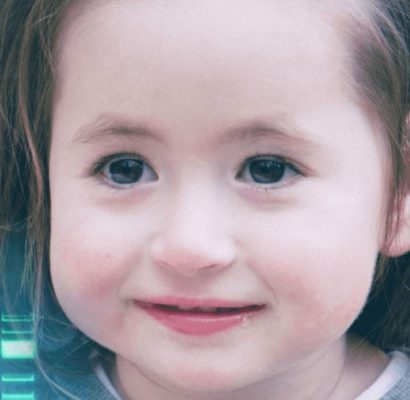
Using just a photograph of a face, a new artificial intelligence tool is surprisingly accurate at diagnosing rare disorders, say researchers. Some rare disorders show up on people’s appearance. People with, for example, Noonan syndrome, may have wide-set eyes. Noonan syndrome is a genetic condition that inhibits the growth and development of the body.
People with Bain type intellectual disability have small chins and almond-shaped eyes (see image above).
Now, a team of researchers has trained an AI tool to recognize facial features. They say their tool is paving the way for early – and low cost – diagnoses.
The researchers, from Tel Aviv University, FDNA Inc., University Hospital Bonn, University Hospital Magdeburg, the University of California San Diego, the A. I. du Pont Hospital for Children/Nemours, Wilmington, wrote about their work in the prestigious journal Nature Medicine (citation below).
DeepGestalt
The authors built DeepGestalt, a computer program. They then trained it on a publicly available data set comprising over 17,000 photographs of people with rare disorders. The dataset had patients with over two-hundred rare disorders.
The software used deep learning to recognize which patterns of markers were associated with hundreds of genetic syndromes.
Earlier diagnosis of rare disorders
Co-author, Dr. Karen Gripp, CMO at FDNA, said:
“This is a long-awaited breakthrough in medical genetics that has finally come to fruition. With this study, we’ve shown that adding an automated facial analysis framework, such as DeepGestalt, to the clinical workflow can help achieve earlier diagnosis and treatment, and promise an improved quality of life.”
FDNA Inc. creates facial dysmorphology novel analysis technology solutions for healthcare professionals. It is based in Boston, Massachusetts, USA. Dysmorphology is the study of congenital anomalies or structural malformations (people commonly use the term ‘birth defects’).
AI (artificial intelligence) refers to software that makes devices such as computers or robots think like us. They also make them behave like us (humans). Some engineers insist that we can only call it AI if it performs at least as well as a human. ‘Perform,’ in this context, refers to human computational speed, capacity, and accuracy.
A test – detecting rare disorders
DeepGestalt underwent a test with 502 new photos. It managed to place the correct syndrome in its top ten list ninety-one percent of the time.
DeepGestalt spotted patients with Angelman syndrome and Cornelia de Lange syndrome versus other rare disorders more accurately than human doctors. It also outperformed doctors in separating patients with different Noonan syndrome genetic subtypes.
The authors believe that one day doctors could use their tool in combination with genome testing. It would help them search for genetic markets, which would allow them to home in on an accurate diagnosis faster.
In an article in Science, Frankie Schembri added:
“This could help reduce the time, cost, and emotional burden of the ‘diagnostic odyssey’ on which millions of families embark each year, seeking care for someone with a rare genetic syndrome.”
Detecting rare disorders and other (sinister) uses
Photographing somebody’s face is easy. Therefore, it would be easy for insurance providers and employers to abuse the tool, the researchers acknowledged.
There will need to be proper rules and regulations for the use and distribution of such tools, they added.
Citation
“Identifying facial phenotypes of genetic disorders using deep learning,” Yaron Gurovich, Yair Hanani, Omri Bar, Guy Nadav, Nicole Fleischer, Dekel Gelbman, Lina Basel-Salmon, Peter M. Krawitz, Susanne B. Kamphausen, Martin Zenker, Lynne M. Bird, and Karen W. Gripp. Nature Medicine, volume 25, pages60–64 (2019). DOI: https://doi.org/10.1038/s41591-018-0279-0.

